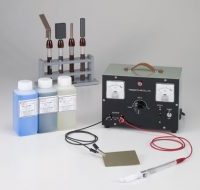- Home
- Brush Plating
- Frequently asked questions about brush plating
TECHNICAL INFORMATION
Frequently asked questions about brush plating
About Material
Q. Can brush plating be performed on aluminum?
A. Brush plating on aluminum is possible.
However, the plating condition varies considerably depending on the series of the aluminum. The 1000 series, which is close to pure aluminum, is difficult to ensure adhesion, while the 5000, 6000, and 2000 series are relatively easy to process.
Also, if the plating film is not etched properly and the oxide film is not removed reliably, the plating film will not adhere and will peel off quickly, so the degree of difficulty of the work is slightly higher than for other metals.
Q. Can brush plating be performed on titanium?
A. Brush plating on titanium is not possible because there is no pretreatment solution suitable for titanium.
Q. Can hard chrome be plated with a brush plating?
A. We do not handle hexavalent chromium due to the theoretical difficulty of brush plating and the fact that the liquid is a hazardous product.
Instead of hard chrome, we offer a chrome-colored plating solution (BP-CR-02 Nickel Cobalt Plating Solution(hexavalent chromium color)).
About how to use
Q. Can we use ordinary plating solution for brush plating?
A. We do not recommend the use of ordinary tank plating solution for brush plating due to the difference in composition between ordinary tank plating solution and brush plating solution.
Q. Is it possible to use carbon brush tool without a degreasing cotton for brush tip?
A. The role of the degreasing cotton is to retain the plating solution and prevent the brush tip from directly touching the treated surface.
In particular, if the brush tip is carbon, some powder will come out from the carbon, so please use a degreasing cotton to prevent contamination.
A small amount of degreasing cotton is also included with the brush tip.
Q. How is silver plating done? Why are the main solution and the A-solution separated?
A. The flow of brush plating is as follows.
Electrolytic degreasing → activation → strike silver plating → silver plating
For silver plating, the solution is mixed just before use to ensure bath stability.
For this reason, the process is divided into 2 parts, the main solution and the A solution, and consists of the following four components.
Strike (main solution) 100mL, Strike (solution A) 500mL
No Cyanide Silver (High Concentration Main solution) 100mL, No Cyanide Silver (High Concentration Liquid A) 500mL
Striking must be performed to prevent peeling of the silver plating to be performed later.
About purchasing
Q. Can anyone purchase brush plating?
A. This is an industrial brush plating and is not sold to individuals. Because the plating solution contains hazardous materials, we restrict this product to businesses entity with a responsible person in charge of handling toxic chemicals.
Q. Do you offer sample plating?
A. We can provide sample plating for a fee on the premise of purchase. However, please note that we may not be able to accept sample plating depending on conditions.
Q. Do you have demo equipment available for rent?
A. No, we do not provide demo or rental equipment for brush plating.




